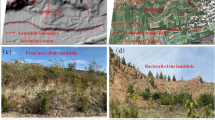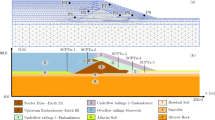Abstract
Smoothed particle hydrodynamics (SPH) is a mesh-free method which is powerful for large deformation computation of soils. However, the algorithm for the simulation of frictional contact which is common in geotechnical engineering is still quite immature due to the boundary deficiency. In this study, the cause of boundary deficiency in the SPH simulation for frictional contact is analysed. Then, based on mathematical derivation, the method to correct boundary deficiency related to frictional contact is discussed theoretically, where the frictional contact algorithm is established by dividing the computational domain into several subdomains according to the existing contact boundaries and by using contact forces as bridges of these subdomains to fulfil problem solving, and the value of correction coefficient is obtained by comparing the SPH outcome of the contact particles with that calculated through Newton’s second law of motion. At the same time, from the perspective of numerical computation, an optimized value for the correction coefficient is proposed, and a thorough investigation is performed on the cubic spline kernel function and quintic spline kernel function, whose correction coefficients are found to be 2.0 and [2.0, 2.16], respectively. Finally, numerical tests are carried out to verify the proposed method. The outcome of the study is helpful to providing theoretical support for the research of frictional contact simulation within the framework of SPH.
Similar content being viewed by others
References
Liu G R, Liu M B. Smoothed Particle Hydrodynamics: A Meshfree Particle Method. Singapore: World Scientific, 2004
Bui H H, Fukagawa R, Sako K, et al. Lagrangian mesh-free particle method (SPH) for large deformation and post-failure of geomaterial using elastic-plastic soil constitutive model. Int J Numer Anal Met, 2008, 32: 1537–1573
Pastor M, Haddad B, Sorbino G, et al. A depth-integrated, coupled SPH model for flow-like landslides and related phenomena. Int J Numer Anal Met, 2009, 33: 143–172
Bui H H, Fukagawa R, Sako K, et al. Slope stability analysis and discontinuous slope failure simulation by elasto-plastic smoothed particle hydrodynamics (SPH). Geotechnique, 2011, 61: 565–574
Chang Y Z, Bao K, Zhu J, et al. A particle-based method for granular flow simulation. Sci China Info Sci, 2012, 55: 1062–1072
Bui H H, Fukagawa R. An improved SPH method for saturated soils and its application to investigate the mechanisms of embankment failure: case of hydrostatic pore-water pressure. Int J Numer Anal Met, 2013, 37:31–50
Wang J, Wu H, Gu C S, et al. Simulating frictional contact in smoothed particle hydrodynamics. Sci China Tech Sci, 2013, 56: 1779–1789
Wang J, Chan D. Frictional contact algorithms in SPH for the simulation of soil-structure interaction. Int J Numer Anal Met, doi: 10.1002/nag.2233
Liu M B, Shao J R, Chang J Z, et al. On the treatment of solid boundary in smoothed particle hydrodynamics. Sci China Tech Sci, 2012, 55: 244–254
Gong K, Liu H, Wang B L. An improved boundary treatment approach for SPH method (in Chinese). Chinese Quart Mech, 2008, 29, 507-514
Monaghan J J, Kajtar J B. SPH particle boundary forces for arbitrary boundaries. Comput Phys Commun, 2009, 180:1811–1820
Campbell J, Vignjevic R, Libersky L. A contact algorithm for smoothed particle hydrodynamics. Comput Method Appl M, 2000, 184: 49–65
Kulasegaram S, Bonet J, Lewis R W, et al. A variational formulation based contact algorithm for rigid boundaries in two-dimensional SPH applications. Comput Mech, 2004, 33:316–325
Seo S W, Min O. Axisymmetric SPH simulation of elasto-plastic contact in the low velocity impact. Compu Phys Commun, 2006, 175: 583–603
Feldman J, Bonet J. Dynamic refinement and boundary contact forces in SPH with applications in fluid flow problems. Int J Numer M, 2007, 72: 295–324
Antoci C, Gallati M, Sibillaet S. Numerical simulation of fluid-structure interaction by SPH. Comput Struct, 2007, 85: 879–890
Wang J, Wang X J, Bian L. Linking of smoothed particle hydrodynamics method to standard finite element method and its application in impact dynamics (in Chinese). Explosion and Shock Waves, 2007, 27: 522–528
Xiao Y H, Han X, Hu D A. Simulating fluid-structure interaction with FE-SPH method (in Chinese). Chinese J Appl Mech, 2011, 28(1): 13–18
Zhang Z C, Qiang H F, Gao W R. Application of SPH-FEM contact algorithm in impact dynamic simulation (in Chinese). Chinese J Solid Mech, 2011, 32: 319–324
Gutfraind R, Savage S B. Smoothed particle hydrodynamics for the simulation of broken-ice fields: Mohr-Coulomb-type rheology and frictional boundary conditions. J Compu Phys, 1997, 134: 203–215
Liu X, Xu H H, Shao S D, et al. An improved incompressible SPH model for simulation of wave-structure interaction, Comput Fluids, 2013, 71: 113–123.
Shao S D, Lo E Y M. Incompressible SPH method for simulating Newtonian and non-Newtonian flows with a free surface. Adv Water Resour, 2003, 26(7): 787–800.
Randles P W, Libersky L D. Smoothed particle hydrodynamics: some recent improvements and applications. Comput Method Appl M, 1996, 139: 375–408
Monaghan J J. Smoothed particle hydrodynamics and its diverse applications. Annu Rev Fluid Mech, 2012, 44: 323–46
Gray J P, Monaghan J J. Swift RP. SPH elastic dynamics. Comput Method Appl M, 2001, 190: 6641–6662
Libersky L D, Petschek A G. High-strain Lagrangian hydrodynamics-a three-dimensional SPH code for dynamic material response. J Comput Phys, 1993, 109: 67–75
Colagrossi A, Landrini M. Numerical simulation of interfacial flows by smoothed particle hydrodynamics. J Comput Phys, 2003, 191: 448–475
Author information
Authors and Affiliations
Corresponding author
Rights and permissions
About this article
Cite this article
Wang, J., Hua, H. & Gu, C. On the correction of the boundary deficiency in SPH for the frictional contact simulation. Sci. China Technol. Sci. 57, 86–100 (2014). https://doi.org/10.1007/s11431-013-5424-x
Received:
Accepted:
Published:
Issue Date:
DOI: https://doi.org/10.1007/s11431-013-5424-x




